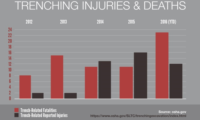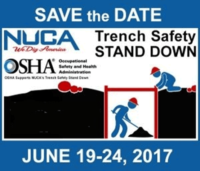They tend to happen more on Mondays. They can occur in an instant. And trench deaths kill about 25 workers a year, according to the Bureau of Labor Statistics (BLS). About 75 percent of those deaths are due to cave-ins, which are largely preventable through cave-in protection and soil analysis. The remainder are mainly caused by struck-bys or electrocutions – also largely preventable.
The National Utility Contractors Association (NUCA) wants to help improve trenching safety with a Trench Safety Stand Down, June 17-21, 2019. Similar to what occurs during OSHA’s National Safety Stand-Down to Prevent Falls in Construction, the trench event invites employers to take a break during a workday during that week and have a toolbox talk – or conduct some other safety activity – with their employees. These talks should focus on trench & excavation hazards and reinforce the importance of using protective systems. The NUCA has materials to help employers have those discussions.
The goal: to make sure that those who work in and around trenches and excavations are informed about current excavation requirements and safety procedures for working in trenches.
Who can participate?
Anyone who wants to prevent trenching and excavation hazards. That includes utility construction, residential, highway construction, plumbers, military, unions, associations, educational institutes, and safety equipment manufacturers.
“By reaching as many workers as possible we can reduce the number of fatalities and serious injuries that occur each year in our industry, and make others, such as municipal and industry workers who are also exposed, aware of these serious hazards,” according to the NUCA.
Causes, preventive measures
An OSHA investigation following a 2003 spike in trench fatalities found that protective systems had been unavailable in a whopping 64 percent of the incidents. Even when protective systems were at the worksite, they were only properly used in 24 percent of the trenches. They were incorrectly used in 24 percent and available but not used in 12 percent.
Environmental conditions were a contributing factor in 68 percent of the fatalities surveyed. Despite that, the competent person was not onsite when the fatality occurred 86 percent of the time. In 65 percent of the fatalities, the employer had not identified the soil type - even though soil type is a factor in trench cave-ins.
And about those dangerous Mondays? A disproportionate number of trench fatalities (36 percent) occurred on Mondays, probably because rain or other factors changed conditions over the weekend. Under OSHA regulations, the competent person must inspect trench work in progress before each shift and after any changes in conditions.
Need to know
Here are OSHA’s General Trenching and Excavation Rules:
- Keep heavy equipment away from trench edges.
- Keep surcharge loads at least 2 feet (0.6 meters) from trench edges.
- Know where underground utilities are located.
- Test for low oxygen, hazardous fumes and toxic gases.
- Inspect trenches at the start of each shift.
- Inspect trenches following a rainstorm.
- Do not work under raised loads.
The NUCA will provide a Certificate of Participation to all participating companies and will publish the names of participating organizations on its NUCA website and in our printed publications.
Click here to find out more about the 2019 Trench Safety Stand Down.



